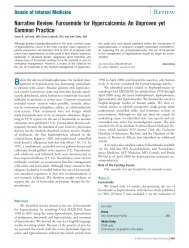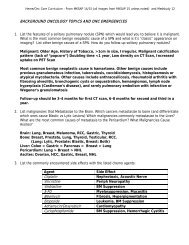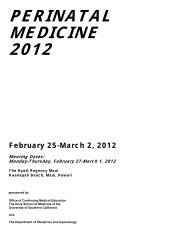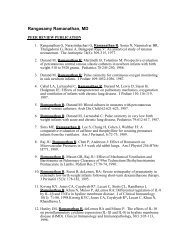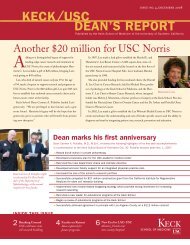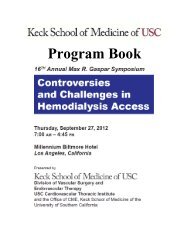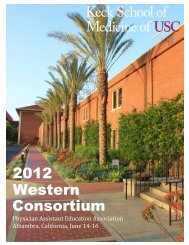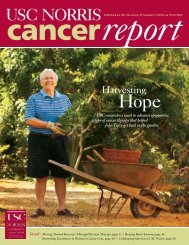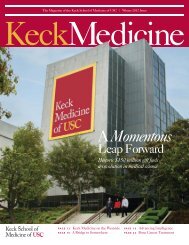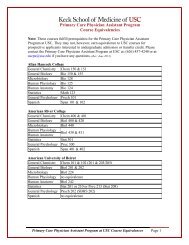F E AT U R E•Faster Treatmentand Recoveryfor CancerIntraoperative radiotherapy following breast lumpectomyspeeds recovery, reduces cost By Mary Ellen ZenkaIntraoperative radiotherapy allowed CathyFriedman to keep running.Dennis R. Holmes, M.D.,with the Intra Beamdevice, which can delivera targeted dose <strong>of</strong>radiati<strong>on</strong> during surgery.22KECK MEDICINE | Winter 2011 IssueHelping people face pers<strong>on</strong>al difficulties is the goal <strong>of</strong>the trauma and crisis interventi<strong>on</strong> organizati<strong>on</strong> whereCathy Friedman is associate director. Last January,Friedman faced her own crisis – she was diagnosedwith breast cancer.“It came as a total surprise,” says Friedman. “I hadabsolutely no risk factors. No <strong>on</strong>e in my family everhad breast cancer. I am a vegetarian who exercisesregularly, and I breast-fed my children.”She knew she needed surgery and was informedabout the standard six weeks <strong>of</strong> post-surgical radiati<strong>on</strong>,but she did not want to endure the l<strong>on</strong>g treatmentand recovery process, and miss running in the LosAngeles Marath<strong>on</strong>. A runner for 30 years, she hasraced in the marath<strong>on</strong> for the past five years.Friedman was referred to Dennis R. Holmes,M.D., director <strong>of</strong> intraoperative radiotherapy andbreast surge<strong>on</strong> at <strong>USC</strong> Norris Comprehensive CancerCenter and Hospital. Holmes explained to Friedmanthat because her type <strong>of</strong> cancer allowed for breastc<strong>on</strong>servati<strong>on</strong>, she would have the opti<strong>on</strong> <strong>of</strong> enteringthe TARGIT Trial – an internati<strong>on</strong>al clinical trial <strong>of</strong>intraoperative radiotherapy.“Rather than the typical multi-week course <strong>of</strong> radiati<strong>on</strong>,the cancer site receives radiotherapy immediatelyafter tumor removal using a device called theIntra Beam, manufactured by Carl Zeiss Meditec,”explains Holmes, who is assistant pr<strong>of</strong>essor <strong>of</strong> clinicalsurgery at the <strong>Keck</strong> <strong>School</strong> <strong>of</strong> <strong>Medicine</strong> <strong>of</strong> <strong>USC</strong>.“The Intra Beam is directed into the breast and canprecisely dispense radiati<strong>on</strong> to the targeted area. Theprocedure takes as little as 17 minutes as compared tothe usual 30-35 days over six weeks.”Standard radiati<strong>on</strong> covers the full breast and cancause injury to surrounding organs and the skin <strong>of</strong> thebreast. The advantage <strong>of</strong> intraoperative radiati<strong>on</strong> isthat a lower dose can be used because the radiati<strong>on</strong>is administered to the interior <strong>of</strong> the breast and doesnot pass through the skin. Intraoperative radiati<strong>on</strong>also permits the temporary inserti<strong>on</strong> <strong>of</strong> internal radiati<strong>on</strong>barriers to protect the underlying heart and lungfrom the effects <strong>of</strong> radiati<strong>on</strong>.An added benefit is the reduced cost <strong>of</strong> treatment –<strong>on</strong>e-third to <strong>on</strong>e-half the cost <strong>of</strong> standard radiotherapy.“More than 2,200 patients around the world havereceived this new form <strong>of</strong> radiotherapy with excellentresults. Cancer recurrence rates using intraoperativeradiotherapy are statistically equivalent to standard radiati<strong>on</strong>techniques,” Holmes says. He is upbeat aboutwhat this means for improving treatment for women.“<strong>USC</strong> Norris is now a leading instituti<strong>on</strong>, and the<strong>on</strong>ly <strong>on</strong>e in Southern California, for both defining thefuture <strong>of</strong> this technology and expanding the trial forpatients who might not have qualified for the TAR-GIT trial,” Holmes says.For Friedman, the choice was simple. The intraoperativetherapy opti<strong>on</strong> was quick with n<strong>on</strong>e <strong>of</strong> the sideeffects comm<strong>on</strong>ly experienced with standard radiati<strong>on</strong>.“I took <strong>on</strong>e week <strong>of</strong>f to recover from my procedure,and I returned to my marath<strong>on</strong> training activitiesthe next week. I am so pleased to have found Dr.Holmes,” Friedman says. “His caring demeanor andrecommendati<strong>on</strong> for my inclusi<strong>on</strong> in the TARGITTrial calmed my breast cancer crisis – something Itruly value.” •For further informati<strong>on</strong> or an appointment, c<strong>on</strong>tactHolmes’ referral coordinator at 323-865-3628.Photo by Philip Channing (left); Photo by Greg Mancuso (top)
F A C U LT Y P R O F I L E •Helping Patients Walk,Run and Play By Martin BooePhoto by Philip ChanningD a n i e l A . O a k e s remembers the exact momentwhen he set his sights <strong>on</strong> becoming an orthopaedicsurge<strong>on</strong>. As a resident doing a rotati<strong>on</strong> in orthopaedics,he assisted in knee replacements for an elderlywoman whose mobility was severely compromisedby rheumatoid arthritis. A day later, he saw her makingher way down the hallway − <strong>on</strong> a walker, yes, butmoving more nimbly than she had in years.“There was the biggest smile <strong>on</strong> her face,” Oakesrecalls. “Her quality <strong>of</strong> life had been restored, andI’ll never forget how thrilled she and her family were,how grateful. I was hooked.”Oakes became director <strong>of</strong> the <strong>USC</strong> Joint ReplacementProgram and associate pr<strong>of</strong>essor <strong>of</strong> clinical orthopaedicsat the <strong>Keck</strong> <strong>School</strong> <strong>of</strong> <strong>Medicine</strong> <strong>of</strong> <strong>USC</strong> inMarch 2010, and he feels like a kid in a candy shop.“The beauty <strong>of</strong> practicing in a surgery care centerlike this is having the instituti<strong>on</strong>al support in anesthesiologyand physical therapy. <strong>USC</strong> has a l<strong>on</strong>g history <strong>of</strong>excellence in joint replacement surgery, and my goal isto c<strong>on</strong>tinue that traditi<strong>on</strong> and establish us as a center <strong>of</strong>excellence for joint replacement,” he says. “We wantto become a destinati<strong>on</strong> for our surrounding community,a place people know they can go for more seriousproblems. We’re doing a high volume <strong>of</strong> revisi<strong>on</strong> surgeries– in other words, we didn’t create the problemsbut we fix them – and that backup [from other departments]enables us to take <strong>on</strong> more difficult cases.”Oakes is no stranger to Southern California, norto <strong>USC</strong>. He was a member <strong>of</strong> the <strong>Keck</strong> <strong>School</strong> facultyfrom 2004 to 2006 before serving as chief <strong>of</strong> theUCLA Joint Replacement Service and assistant pr<strong>of</strong>essor<strong>of</strong> orthopaedic surgery. At UCLA, he developeda thriving joint replacement divisi<strong>on</strong> and wasa leader in resident educati<strong>on</strong>. He returned to theTrojan family in 2010.Oakes was born in Bost<strong>on</strong> but grew up in the BayArea. A Harvard Medical <strong>School</strong> graduate, he completedhis residency training and a research fellowshipin orthopaedic surgery at UCLA Medical Center.Oakes completed an adult rec<strong>on</strong>structi<strong>on</strong> fellowshipat the Mayo Clinic in Rochester, Minn.His wife, Vanessa Walker-Oakes, is an art historianwho teaches Advanced Placement Art History and is thedirector <strong>of</strong> college counseling at the Flintridge Preparatory<strong>School</strong> in La Cañada. The couple has four young s<strong>on</strong>s.Oakes saw dramatic advances in hip and knee replacementprocedures during his residency, and thepace <strong>of</strong> change has <strong>on</strong>ly accelerated since then. The use<strong>of</strong> less invasive surgical approaches in c<strong>on</strong>juncti<strong>on</strong> withregi<strong>on</strong>al anesthetic protocols, rather than general anesthesia,has helped to better c<strong>on</strong>trol post-operative pain,improve early mobility and shorten hospital stays.The patient demographic requiring total joint replacementsurgery is changing, as patients are younger,more active and have high functi<strong>on</strong>al expectati<strong>on</strong>safter surgery. Treatment <strong>of</strong> the younger patient is an<strong>on</strong>going area <strong>of</strong> research.Infecti<strong>on</strong>s after a hip or knee replacement are <strong>on</strong>e<strong>of</strong> the most feared complicati<strong>on</strong>s (nati<strong>on</strong>al infecti<strong>on</strong>rate is 0.5 percent). The <strong>USC</strong> Joint Replacement Programhas tremendous experience in caring for thesepatients with good success.“The less<strong>on</strong> learned from these cases is that more attenti<strong>on</strong>needs to be given to preventi<strong>on</strong>. While we knowhow to treat infecti<strong>on</strong> cases, we are becoming even betterat preventing them from occurring,” Oakes says.“There’s a lot <strong>of</strong> satisfacti<strong>on</strong> knowing your patientsare going to get better with the right operati<strong>on</strong>, andthat’s what I love about joint replacement surgery,”he says. “Part <strong>of</strong> the challenge is that people’s expectati<strong>on</strong>sare so much higher. Performing activities<strong>of</strong> daily living and walking without pain used to bec<strong>on</strong>sidered a success. Our patients today are muchmore active than their predecessors. Now they wantto ride 100-mile bike rides and play in competitivetennis tournaments. We’re always striving to improveto keep up with increasing inpatient expectati<strong>on</strong>s.”As for Oakes’ extracurricular activities: well, hehas those four young boys, ages 1 to 11. Spare time?“What’s that?” he jokes. •For a joint replacement c<strong>on</strong>sultati<strong>on</strong>, c<strong>on</strong>tact 323-442-5860or uscjointreplacement@health.usc.edu.Daniel Oakes, M.D.,brings a wealth <strong>of</strong>experience in replacingdeteriorated joints, suchas hips, with state-<strong>of</strong>the-artprostheses.keck.usc.edu KECK MEDICINE 23



